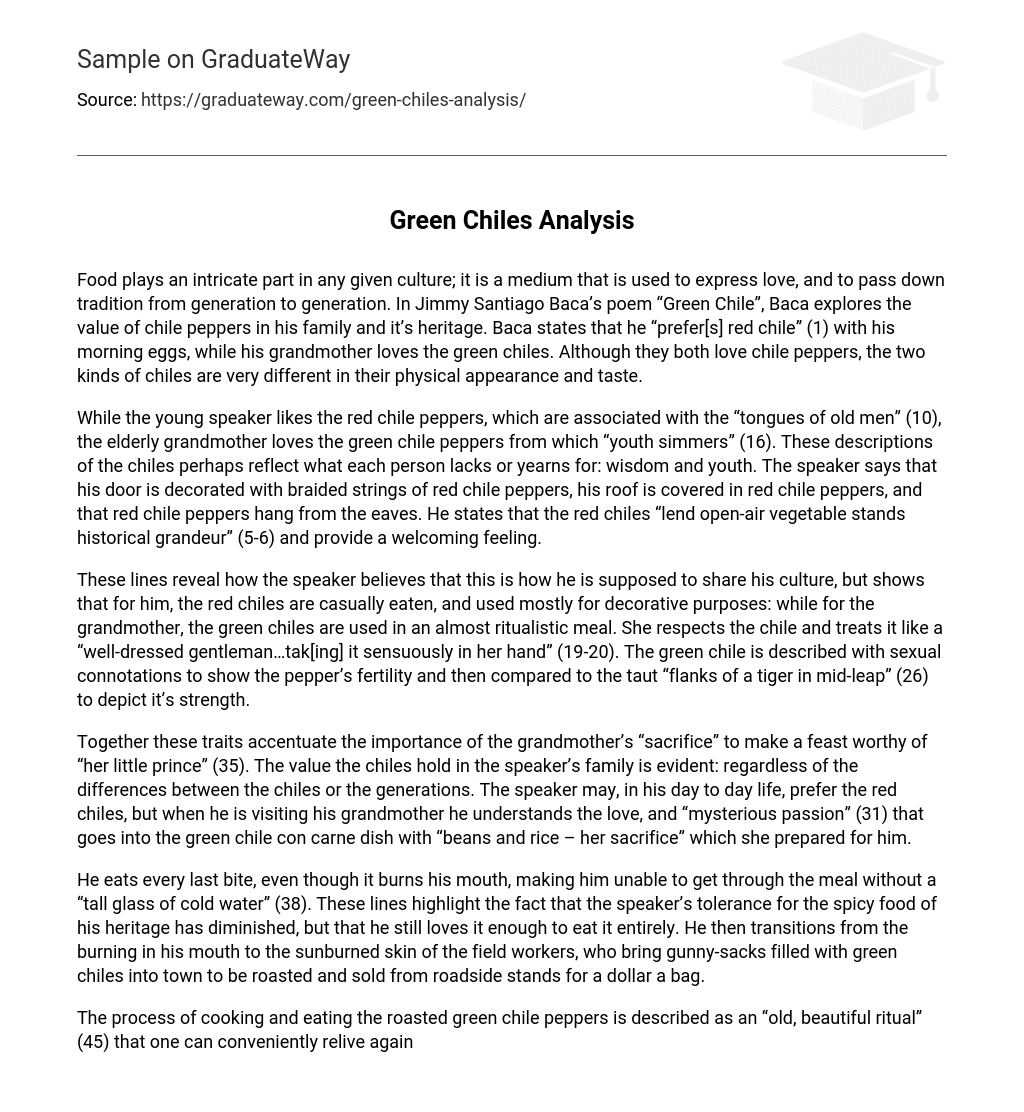Food plays an intricate part in any given culture; it is a medium that is used to express love, and to pass down tradition from generation to generation. In Jimmy Santiago Baca’s poem “Green Chile”, Baca explores the value of chile peppers in his family and it’s heritage. Baca states that he “prefer[s] red chile” (1) with his morning eggs, while his grandmother loves the green chiles. Although they both love chile peppers, the two kinds of chiles are very different in their physical appearance and taste.
While the young speaker likes the red chile peppers, which are associated with the “tongues of old men” (10), the elderly grandmother loves the green chile peppers from which “youth simmers” (16). These descriptions of the chiles perhaps reflect what each person lacks or yearns for: wisdom and youth. The speaker says that his door is decorated with braided strings of red chile peppers, his roof is covered in red chile peppers, and that red chile peppers hang from the eaves. He states that the red chiles “lend open-air vegetable stands historical grandeur” (5-6) and provide a welcoming feeling.
These lines reveal how the speaker believes that this is how he is supposed to share his culture, but shows that for him, the red chiles are casually eaten, and used mostly for decorative purposes: while for the grandmother, the green chiles are used in an almost ritualistic meal. She respects the chile and treats it like a “well-dressed gentleman…tak[ing] it sensuously in her hand” (19-20). The green chile is described with sexual connotations to show the pepper’s fertility and then compared to the taut “flanks of a tiger in mid-leap” (26) to depict it’s strength.
Together these traits accentuate the importance of the grandmother’s “sacrifice” to make a feast worthy of “her little prince” (35). The value the chiles hold in the speaker’s family is evident: regardless of the differences between the chiles or the generations. The speaker may, in his day to day life, prefer the red chiles, but when he is visiting his grandmother he understands the love, and “mysterious passion” (31) that goes into the green chile con carne dish with “beans and rice – her sacrifice” which she prepared for him.
He eats every last bite, even though it burns his mouth, making him unable to get through the meal without a “tall glass of cold water” (38). These lines highlight the fact that the speaker’s tolerance for the spicy food of his heritage has diminished, but that he still loves it enough to eat it entirely. He then transitions from the burning in his mouth to the sunburned skin of the field workers, who bring gunny-sacks filled with green chiles into town to be roasted and sold from roadside stands for a dollar a bag.
The process of cooking and eating the roasted green chile peppers is described as an “old, beautiful ritual” (45) that one can conveniently relive again, and again for only a dollar. This roadside ritual keeps the culture behind the food alive and thriving; even if that means that the new generation prefers the red chile. Jimmy Santiago Baca writes about chile peppers, and the significance they hold to a family. Through the generations, this family’s customs and preferences have changed as they do amongst many families; especially those who have migrated from their home countries.
Although these families are geographically relocated, the culture clings to the generations that develop in these new countries. The cultural food of one’s heritage can be what remains long after the language and religion has faded into the ages, and this is shown in “Green Chile”. The speaker in the poem shows that although he now lives in New Mexico, and prefers red chile peppers, he still has a love and appreciation for the cultural dish that his grandmother prepares with green chiles, and the ritual of roasting green chile peppers lives on through roadside stands for anyone to enjoy.





